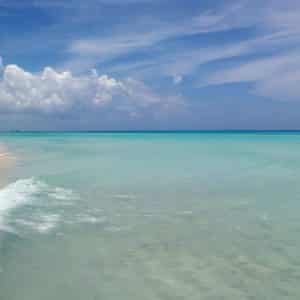Highlights
Overview
Welcome to VARADERO, Cuba!
Varadero is a relatively exclusive part of Cuba, abundant with private hotels, gorgeous beaches and the country’s only full golf course. The fantastic beaches with clear turquoise warm water makes this an island lovers paradise.
Getting In
Juan Gualberto Gomez Airport. Many package tours fly directly to Varadero from Canada and from Europe. There is a currency exchange booth only in the departures hall. The booth in the arrivals hall is now closed, but there is one on the outside of the airport across from the passenger pick-up. There is also one past security in the waiting hall.
Taxi from airport to the town (about 10km) costs about 25-30 CUC. It may be possible to bargain the fare to about 20 CUC, but not much less. Alternately you can walk out to the airport parking lot and tip (5-10 CUC) one of the tour bus drivers to hitch a ride to your hotel/resort – this always works out cheaper than taxi if you travel solo.
Viazul Buses arrive from Havana and Matanzas three times daily. These buses also stop at the Varadero airport. They run a daily overnight service from Santiago de Cuba, stopping at Sancti Spiritus, Camagüey, and Santa Clara in the middle of the night. There is also a morning bus to Santa Clara, Cienfuegos, and Trinidad, returning in the afternoon/early evening.
Hiring a car is also possible in the Varadero Airport or through various hotels. It may also be possible to get to Havana on a hotel transfer bus for about 10 CUC by negotiating with the driver. There are no trains.
Getting Around
Many visitors do not stray far from their package tour hotel. Depending on how close to the town of Varadero your hotel is located, many opportunities to explore either on foot or with a vehicle are present. Visitors staying at Varadero beach hotels (pretty much from the Internacional Hotel or past) end up walking the beach. Any trip to town will require a ride. Those staying in Varadero town have many options on foot.
By Bus
There is a double-decker open-on-top bus that runs on a regular schedule from the tip of the peninsula (up by the Blau Marina Hotel and Princessa del Mar) all the way into the town of Varadero, with stops at the International Centre (shopping mall with about 100 stores, and restaurants), the open-air marketplace, and most major hotels. Look for the blue sign-posts to indicate stops, routing, and schedules. 5 CUC gets you a day pass that you can use as much as you want goes along the whole peninsula. Watch out for the palm tree branches when sitting on the open top, the branches may whack you in the head.
By Taxi
All hotels will have a taxi stand. Fares are either metered or set by distance. Some hotels, mostly the better ones, have car rentals available right at the hotel. There are also several rental outlets in Varadero.
Buying Currency
In tourist facilities and other service units, prices are set in Cuban Convertible Pesos (CUC). In Varadero, Cayo Largo del Sur, Jardines del Rey (Coco and Guillermo Keys), Santa Lucía Beach, Covarrubias Beach, and Holguín province, you can also pay in euros. Credit Cards (except those issued by US banks or their branches in other countries) can be used in most Varadaro shops but it is more useful to take cash (CUCs) to the markets.
Currency Exchange
In Cuba , there are two different currencies: Cuban Convertible Pesos (CUC) and Cuban Pesos (CUP). (1 CUC=24 CUP).
You may exchange Euros, Canadian dollars, Pounds, Swiss francs, and others for Cuban Convertible Pesos. The exchange rates for those currencies are set in accord with the exchange rates on the international market. You can acquire ‘pesos convertibles’ at the airport, banks and at the Money Exchange Offices, called “CADECA” (you can find these offices everywhere in the country). You can obtain Cuban Pesos also in the CADECAs or at any local bank or at the front desk of your resort.
Make sure you count your change at CADECA before leaving the booth. The exchange booth at the Varadero Airport is known to short-change tourists by trimming it to the nearest 10 CUC, which is never a practise throughout the country as they’re supposed to give change to the nearest 5 centavos (0.05 CUC).
Shopping
Beach Vendors are abundant on the beaches bracketing the resorts. Their “carts” are built up from a bicycle with many shelves and hooks to display their wares while easily rolling along the beach. Haggling is not as common in Cuba as it is in the Dominican but it can be done.
The usual items that people shop for in Cuba are rum, cigars, coffee and jewelry.
Rum is best purchased at the Casa de Ron, this shop has the best selection. Though other small grocery stores and hotel gift shops stock the favorites.
Across the street from the Casa de Ron is the cigar shop. Again, the selection is enormous and the prices are better than in some of the hotel gift shops.
Eating
Many packages are “all-inclusive” at major resorts, especially those further up the peninsula. These cater primarily to North American tourists, who make up the bulk of visitors. Some of them do offer room/hotel packages (EP, or European Plan), but they are becoming harder to find. Most hotels past the golf course are all-inclusive by circumstance, as there are few nearby restaurants. There is a very good restaurant at the Marina, and several at the International Shopping Centre. The clubhouse at the Varadero Golf Course (this was the old Dupont Mansion) has an extensive menu and a lovely setting overlooking the ocean on one side, the golf course on the other.
In the town of Varadero, there is everything from open-air marketplace-type food stalls to the local version of fast food. In town you can find: Pollo Loco (pronounced Po-Yo Lo-Ko, or crazy chickens), hamburguesas con queso (cheeseburgers), sandwiches (surprisingly, pressed Cuban sandwiches are hard to find), and the odd pizza joint. There are also a few restaurants serving sit-down dinners and lunches. Chicken, pork and fish are the most frequent items, but beef is not hard to find. Menus are usually posted outside.
Visitors staying at any of the hotels in town have many choices. Many of these hotels are older and nowhere near as fancy as the beach resorts, and they cater to a different clientele.
Drinking
The Mojito is Cuba’s signature drink. Made with freshly crushed mint, lime juice and white rum it is a unique delicious flavour. Second to the Mojito is the Cuba Libre, a combination of rum, cola and lime juice.
Cristal beer can be had for a dollar a can. It is a good tasting light pilsner. Mayabe is another good beer, not as light at Cristal and not as heavy as the much stronger Bucanero or Bucanero Fuerte. Most all inclusive resorts stock both Cristal and Bucanero.
Caney is made in the former Bacardi factory on the east end of the island. It is Cuba’s premium brand of rum. It’s available in Carta Blanca (white), or traditionally darker varieties of differing aging quality. Rum is called “Ron” in Cuba and “Ron Mulatta” is a cheaper brand often supplied to inclusive hotels (it tastes just as good). If you don’t drink Rum you might want to stop into the duty free store on the way down and bring your favorite drink. Low quality Russian Vodka can be obtained in Havana, but high quality spirits are hard to find and expensive as it caters to Cuba’s tourists.
Wine made in Cuba is very sweet and not all that far from grape juice. It has its charms but true wine lovers may want to bring a bottle from home or the duty free shop.
Cubans also drink plenty of coffee, and they like to brew it strong. Order café espresso for a straight shot, or café con leche if you’d like it mixed with warm milk. Ask for café americano if you want a milder brew.
You can drink the water in Cuba but it is recommended that you purchase bottled water, which is available throughout the island in hotels and resorts. Another option is to buy a big bottle of water on your first days and keep refilling it at the resort drink fountains where water, cola and other soft drinks are dispensed.
Staying Safe
Cuba in general, and Varadero in particular, are very safe places for travellers. Varadero is pretty strictly a tourist enclave, with limited access for locals, and routinely policed. Elsewhere in Cuba is much different. It is, however, arguably the safest country in the Caribbean for travelers, including single females. Use your common sense and you’ll be fine.
Credit card scam at Varadero Airport — This scam involves storekeepers in small shops taking out a purchase as a cash advance on your credit card. When the victim tries to purchase, the shopkeeper says ‘one moment’ and goes to an accomplice working at the CADECA cash exchange counter to give the amount of the cash advance and the card number. The CADECA teller then processes the cash advance, and the storekeeper asks the victim to return to show passport and sign. The receipt appears like a sale as it is written ‘VENTA’. The bank teller gives the cash directly to the shopkeeper. In addition, the shopkeeper can easily give a box of fake cigars from a bag or other source. Because the receipt comes from the bank counter and the client has signed for what is supposedly a cash advance, credit card companies (i.e. MasterCard) are reluctant to refund or complain against this particular (and very lucrative) merchant. The lesson for the tourist is to never let one’s credit card out of one’s hands, and even then in many places it is better to pay cash. Also, shops are less expensive after Customs than in the pre-checkin lounge. CAVEAT EMPTOR!
Beach Safety — The flag system on the beaches is simple to learn and will keep you safe while enjoying your vacation. Red flag, no swimming. Yellow flag, be cautious. Green flag, go swim. Remember that strong tides can pull you out further than you intended to go and then keep you out there. Life guards often can be seen patrolling wearing Red Cross symbols on their shirts.
Getting Out
There is no money exchange booth (Cadeca) in the Arrivals Hall. The only Cadeca at the airport is in the departure area where there are many duty free shops catering to Cuban rum, cigars, artwork and other merchandise.
A list of contributors is available at the original article on Wikitravel.
Forecast

 Varadero
Varadero 

Post New Review